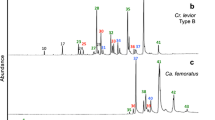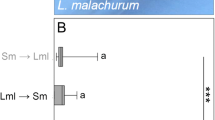Abstract
In social insects, the integrity of a colony is maintained by recognising and removing intruders. Nest-mates use chemical cues on the cuticle of the individual they encounter to determine whether or not it is part of the colony. Parasites have evolved to take advantage of this recognition system by mimicking these chemical cues to gain entry into the colony and therefore, avoid being attacked by the host during their stay. The ectoparasitic mite Varroa destructor uses chemical camouflage to access and remain undetected inside colonies of its honey bee host, Apis mellifera. It remains, however, to be tested whether the mite also mirrors colony-specific cues to retain its camouflage when switching host colonies. Here, we show that the mite’s chemical mimicry is colony-specific and that these colony-specific differences were based on differences in the n-alkane and alkene part of the mite’s chemical profile, even though overall chemical mimicry was imperfect.


Similar content being viewed by others
References
Aitchison J (1986) The statistical analysis of compositional data. Chapman and Hall, London
Akino T, Knapp JJ, Thomas JA, Elmes GW (1999) Chemical mimicry and host specificity in the butterfly Maculinea rebeli, a social parasite of Myrmica ant colonies. Proc Royal Soc London Ser B-Biol Sci 266:1419–1426
Arnold G, Quenet B, Masson C (2000) Influence of social environment on genetically based subfamily signature in the honeybee. J Chem Ecol 26:2321–2333
Aumeier P, Rosenkranz P, Francke W (2002) Cuticular volatiles, attractivity of worker larvae and invasion of brood cells by Varroa mites. A comparison of Africanized and European honey bees. Chemoecology 12:65–75
Bagnères A-G, Lorenzi MC (2010) Chemical deception/mimicry using cuticular hydrocarbons. In: Blomquist GJ, Bagnères A-G (eds) Insect hydrocarbons: biology, biochemistry, and chemical ecology. University Press, Cambridge, pp 282–324
Bagnères A-G, Killian A, Clément J-L, Lange C (1991) Interspecific recognition among termites of the genus Reticulitermes: evidence for a role for the cuticular hydrocarbons. J Chem Ecol 17:2397–2420
Blomquist GJ, Howard RW, McDaniel CA, Remaley S, Dwyer LA, Nelson DR (1980) Application of methoxymercuration-demercuration followed by mass-spectrometry as a convenient microanalytical technique for double-bond location in insect-derived alkenes. J Chem Ecol 6:257–269
Boecking O, Spivak M (1999) Behavioral defenses of honey bees against Varroa jacobsoni Oud. Apidologie 30:141–158
Breed MD (1998) Recognition pheromones of the honey bee. Bioscience 48:463–470
Buchwald R, Breed MD (2005) Nestmate recognition cues in a stingless bee, Trigona fulviventris. Anim Behav 70:1331–1337
Butts DP, Camann MA, Espelie KE (1995) Workers and queens of the European hornet Vespa crabro L. have colony-specific cuticular hydrocarbon profiles (Hymenoptera, Vespidae). Insectes Soc 42:45–55
Châline N, Sandoz JC, Martin SJ, Ratnieks FLW, Jones GR (2005) Learning and discrimination of individual cuticular hydrocarbons by honey bees (Apis mellifera). Chem Senses 30:327–333
Cini A, Bruschini C, Signorotti L, Pontieri L, Turillazzi S, Cervo R (2011) The chemical basis of host nest detection and chemical integration in a cuckoo paper wasp. J Exp Biol 214:3698–3703
Dani FR, Foster KR, Zacchi F, Seppa P, Massolo A et al (2004) Can cuticular lipids provide sufficient information for within-colony nepotism in wasps? Proc Royal Soc London Ser B-Biol Sci 271:745–753
Dani FR, Jones GR, Corsi S, Beard R, Pradella D, Turillazi S (2005) Nest mate recognition cues in the honey bee: differential importance of cuticular alkanes and alkenes. Chem Senses 30:477–489
Dapporto L, Fondelli L, Turillazzi S (2006) Nestmate recognition and identification of cuticular hydrocarbons composition in the swarm founding paper wasp Ropalidia opifex. Biochem Syst Ecol 34:617–625
Dettner K, Liepert C (1994) Chemical mimicry and camouflage. Annu Rev Entomol 39:129–154
Elgar MA, Allan RA (2004) Predatory spider mimics acquire colony-specific cuticular hydrocarbons from their ant model prey. Naturwissenschaften 91:143–147
Elgar MA, Allan RA (2006) Chemical mimicry of the ant Oecophylla smaragdina by the myrmecophilous spider Cosmophasis bitaeniata: is it colony-specific? J Ethol 24:239–246
Greene MJ, Gordon DM (2007) Structural complexity of chemical recognition cues affects the perception of group membership in the ants Linephithema humile and Aphaenogaster cockerelli. J Exp Biol 210:897–905
Guillem RM, Drijfhout F, Martin SJ (2014) Chemical deception among ant social parasites. Curr Zool 60:62–75
Hölldobler B, Carlin NF (1987) Anonymity and specificity in the chemical communication signals of social insects. J Comp Physiol Sens Neural Behav Physiol 161:567–581
Hölldobler B, Wilson EO (1990) The ants. Harvard University Press, Cambridge
Howard RW, Blomquist GJ (2005) Ecological, behavioral, and biochemical aspects of insect hydrocarbons. Annu Rev Entomol 50:371–393
Howard RW et al (1980) Chemical mimicry as an integrating mechanism: cuticular hydrocarbons of a termitophile and its host. Science 210:431–433
Howard RW, Stanley-Samuelson DW, Akre RD (1990) Biosynthesis and chemical mimicry of cuticular hydrocarbons from the obligate predator, Microdon albicomatus Novak (Diptera: Syrphidae) and its ant prey, Myrmica incompleta Provancher (Hymenoptera: Formicidae). J Kansas Entomol Soc 63:437–443
Johnson BR, van Wilgenburg E, Tsutsui ND (2011) Nestmate recognition in social insects: overcoming physiological constraints with collective decision making. Behav Ecol Sociobiol 65:935–944
Kaib M, Jmhasly P, Wilfert L, Durka W, Franke S, Francke W et al (2004) Cuticular hydrocarbons and aggression in the termite Macrotermes subhyalinus. J Chem Ecol 30:365–385
Kather R, Drijfhout FP, Martin SJ (2011) Task group differences in cuticular lipids in the honey bee Apis mellifera. J Chem Ecol 37:205–212
Kather R, Drijfhout FP, Shemilt S, Martin SJ (2015) Evidence for passive chemical camouflage in the parasitic mite Varroa destructor. J Chem Ecol. doi:10.1007/s10886-015-0548-z
Kraus B, Koeniger N, Fuchs S (1986) Unterscheidung zwischen Bienen verschiedenen Alters durch Varroa jacobsoni Oud. und Bevorzugung von Ammenbienenvolk. Apidologie 17:257–266
Lenoir A, Malosse C, Yamaoka R (1997) Chemical mimicry between parasitic ants of the genus Formicoxenus and their host Myrmica (Hymenoptera, Formicidae). Biochem Syst Ecol 25:379–389
Lenoir A, D’ettorre P, Errard C (2001) Chemical ecology and social parasitism in ants. Annu Rev Entomol 46:573–599
Martin SJ, Bayfield J (2014) Is the bee louse Braula coeca (Diptera) using chemical camouflage to survive within honeybee colonies? Chemoecology 24:165–169. doi:10.1007/s00049-014-0158-1
Martin SJ, Vitikainen E, Shemilt S, Drijfhout FP, Sundstrom L (2013) Sources of variation in cuticular hydrocarbons in the ant Formica exsecta? J Chem Ecol 39:1415–1423
Nation JL, Sanford MT, Milne K (1992) Cuticular hydrocarbons from Varroa jacobsoni. Exp Appl Acarol 16:331–344
Oksanen, J. 2013. Package ‘vegan’. R version 2.0-10
Ruther J, Sieben S, Schricker S (1998) Role of cuticular lipids in nestmate recognition of the European hornet Vespa crabro L. (Hymenoptera, Vespidae). Insectes Soc 45:169–179
Sledge MF, Boscaro F, Turillazzi S (2001) Cuticular hydrocarbons and reproductive status in the social wasp Polistes dominulus. Behav Ecol Sociobiol 49:401–409
Vander Meer RK, Wojcik DP (1982) Chemical mimicry in the Myrmecophilous beetle Myrmecaphodius excavaticollis. Science 218:806–808
Wagner D, Jones JB, Gordon DM (2000) Harvester ants utilize cuticular hydrocarbons in nestmate recognition. J Chem Ecol 26:2245–2257
Acknowledgments
We thank Roger Butlin of Sheffield University and the two reviewers for comments on the script and the National Bee Unit at the Food and Environment Research Agency for access to their hives. Thanks also go to Rüdiger Riesch for advice on the DA methodology. This research was funded by BBSRC (BB/G017077/1), NERC (NE/F018355/1) and the East Anglian Beekeepers (EARS).
Author information
Authors and Affiliations
Corresponding author
Additional information
Handling Editor: Michael Heethoff.
Rights and permissions
About this article
Cite this article
Kather, R., Drijfhout, F.P. & Martin, S.J. Evidence for colony-specific differences in chemical mimicry in the parasitic mite Varroa destructor . Chemoecology 25, 215–222 (2015). https://doi.org/10.1007/s00049-015-0191-8
Received:
Accepted:
Published:
Issue Date:
DOI: https://doi.org/10.1007/s00049-015-0191-8




